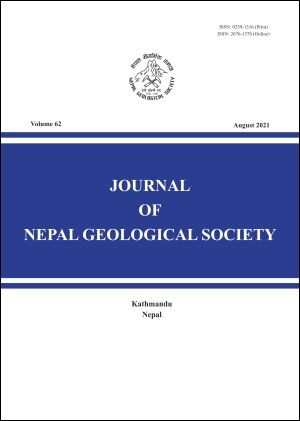Hydro-torrential hazard vs. anthropogenic activities along the Seti valley, Kaski, Nepal: Assessment and recommendations from a risk perspective
DOI:
https://doi.org/10.3126/jngs.v62i0.38695Keywords:
Seti River, Anthropogenic activities, Disaster, Fluvial riskAbstract
The Seti River originates from the Annapurna Massif in the Higher Himalaya of Nepal and flows through the Pokhara valley in the Lesser Himalaya. The Seti River witnessed a disastrous flash flood on May 5th, 2012 causing the death of 72 people, obliterating dozens of homes and damaging infrastructures worth millions of dollars. Despite the 2012 flood event and several warnings by scientists for more yet bigger scale future floods in the Seti valley, fluvial risk is being aggravated by anthropogenic activities such as unplanned human settlement, encroachment of riverbanks, haphazard construction of road, drinking water, and hydropower projects in potential flood hazard areas in addition to the increased impacts of climate change on geological and hydro-metrological hazards as in other parts of Hindu Kush Himalayan Range. Covering some 40-km distance from the Seti headwater (Sabche Cirque) down to Pokhara city, the study is carried out based on hydro-geomorphological mapping, analysis of land-use and land-cover change, hydrological analysis including HEC-RAS modelling, historical archives, and interviews with local people. The study shows a significant change on the land use and land cover of the Seti catchment, mainly the urban/built-up area, which is increased by 405% in 24 years period (1996 to 2020) and by 47% in 7 years period (2013 to 2020). Further the study reveals that anthropogenic activities along the Seti valley have increased fluvial risk and are likely to invite more disasters. From the HEC-RAS analysis, two motor bridges built over Seti River were found to have insufficient freeboard to safely pass the highest flood discharge for 100 years return-period. Instead of relocating people to safer places, the government and local authorities rather seem to have encouraged people to live in the floodplain by providing basic amenities such as drinking water, electricity and access road. Given the context of climate change and Pokhara valley and the Seti catchment being in a high-seismic gap zone, there is a strong possibility of similar flood to the scale of 2012 or even greater in Seti River. Though the fluvial risk can be managed in a sustainable way through the application of functional space concept, i.e., by allowing more space (freedom) for rivers, this economic and environment friendly approach of the fluvial risk management has not been implemented yet in the Seti valley nor in Nepal. Rather the encroachment of floodplains by anthropogenic activities along the Seti valley is on an increasing trend. Many settlements and infrastructures along the valley have been identified vulnerable to hydro-torrential hazards, therefore it is utmost necessity to implement functional space river concept, land use and land plan policy, early warning system and public awareness education in order to mitigate and manage the future impact of fluvial hazards along the Seti valley.
Downloads
Downloads
Published
How to Cite
Issue
Section
License
© Nepal Geological Society




